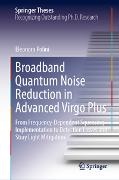Ulteriori informazioni
This book presents the first implementation of frequency-dependent squeezing in the Virgo gravitational wave detector, a technique that reduces quantum noise across the entire detection band. By lowering noise, it enhances Virgo’s ability to observe the universe.
It provides a detailed account of the experimental optical system—spanning hundreds of meters—and the measurement campaign that led to the first observation of frequency-dependent squeezing, with ellipse rotation occurring at the target frequency of a few tens of Hz. Additionally, the book covers the characterization and commissioning of a new Output Mode Cleaner cavity in Virgo to minimize optical losses on squeezed states. Finally, it examines the impact of stray light noise at low frequencies and explores mitigation strategies to improve detector sensitivity.
Sommario
Gravitational waves.- Ground based gravitational waves detectors.- Theory of quantum light in gravitational waves detectors.- Quantum noise reduction system overview in Advanced Virgo Plus.- Quantum noise reduction system commissioning.- Stray light in gravitational waves detectors.- Ghost beams study and mitigation.- Active control of scattered light on the FDS system.- Matching of the squeezing beam to the ITF.- New high finesse Output Mode Cleaner for Advanced Virgo Plus.
Info autore
Eleonora Polini is a physicist specializing in quantum noise reduction for gravitational wave detectors. She earned her Bachelor’s and Master’s degrees in Physics from La Sapienza University of Rome, where she received the Enrico Persico and Tito Maiani Prizes for academic excellence.
She completed her PhD at the Laboratoire d’Annecy de Physique des Particules and Université Savoie Mont Blanc, focusing on frequency-dependent squeezing in the Virgo detector. Her work included upgrading the Output Mode Cleaner cavity and investigating stray light noise, earning her the Virgo Award (2022) and GWIC–Braccini Prize (2023).
She later conducted postdoctoral research at MIT, working on scattered light analysis for LIGO Hanford, assembling Output Mode Cleaner cavities at Caltech, and developing fiber interferometers for entangled-state gravitational measurements.
Currently, she is a Research Scientist at CNRS in the ARTEMIS laboratory at the Observatoire de la Côte d'Azur, focusing on gravitational wave detectors (current and future) and fundamental physics experiments.
Riassunto
This book presents the first implementation of frequency-dependent squeezing in the Virgo gravitational wave detector, a technique that reduces quantum noise across the entire detection band. By lowering noise, it enhances Virgo’s ability to observe the universe.
It provides a detailed account of the experimental optical system—spanning hundreds of meters—and the measurement campaign that led to the first observation of frequency-dependent squeezing, with ellipse rotation occurring at the target frequency of a few tens of Hz. Additionally, the book covers the characterization and commissioning of a new Output Mode Cleaner cavity in Virgo to minimize optical losses on squeezed states. Finally, it examines the impact of stray light noise at low frequencies and explores mitigation strategies to improve detector sensitivity.

